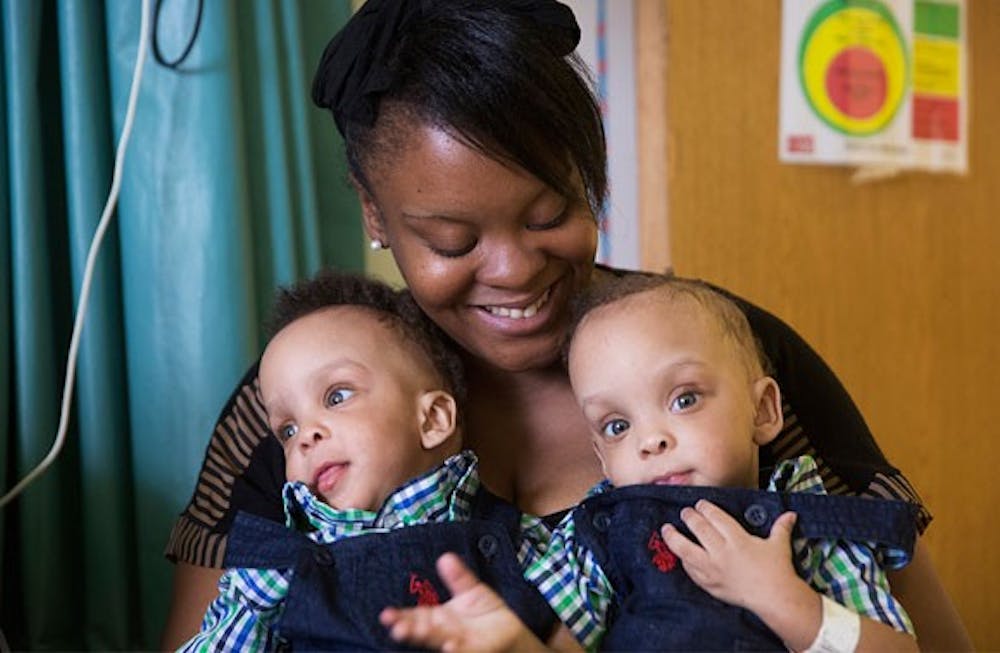Surgeons at Duke University Medical Center performed a successful separation of conjoined twins last month, and both twins are now recovering well.
The twin boys, Josiah and Aryan Covington, were conjoined at the abdomen—from the lower part of their breast bone to their belly button—and shared a single liver until undergoing surgery at eight months old. Dr. Henry Rice, division chief of pediatric surgery, led the team of surgeons that performed the procedure on June 18. Separations of conjoined twins are rare—this was the first of its kind in North Carolina in 15 years and the first ever at Duke.
“It went really well—the difficulty of this operation depends on what parts of the body are fused together and how disabled the twins were before,” Rice said. “There are many situations where only one twin survives or the other is very disabled, but each of these twins essentially has normal body function and should develop and thrive just like any other boy.”
Vanessa Covington, the 30-year-old mother of the twins, received the news that the two were conjoined while she was pregnant. Faced with a difficult decision, she said she overcame her fears to give birth to the children.
“[The doctors] said an option was to have an abortion, but I decided to have them because they deserve to be in this world just like any other babies,” she said.
After the twins were born, Covington began making trips from her home in Dunn, N.C., to Duke to meet with the team of doctors preparing for the separation. The doctors chose to wait until the twins were eight months old to ensure that their bodies grew safely, Rice said.
The months before the separation required many hours of preparation, including a dress rehearsal during which the surgeons ran through each of the procedures involved. Plastic surgeons also performed a tissue expansion—an operation to stretch out the babies’ skin over several months—allowing each twin to have enough skin post-separation.
“Each step takes an extraordinary amount of teamwork and planning, and elements that we don’t do everyday,” Rice said. “This took a big team because it’s as complicated a surgery as it gets.”
The separation itself was focused on the underlying abdominal organs that were connected, including their fused liver, Rice explained. Over the course of nine hours, the team of surgeons separated skin and soft tissue before dividing the liver. The final step was soft tissue reconstruction of the twins' abdominal walls. Very few complications arose during the surgery, Rice said.
The boys then spent 21 days being monitored in the hospital, but are now recovering at home with their mother.
“It takes time to see how they’ll do, particularly for their bone development,” Rice said. “Their spines were curved together, so hopefully they will straighten over time. That'll take a couple years to see.”
Rice attributes the success of the procedure to his team, which included seven surgeons and two full anesthesiology teams, each with strengths and expertise of their own. He said many members had done similar procedures before at other institutions.
“It’s the first time all of us have done it together, almost like putting on a play that’s never been shown before,” he said. “You need to be able to assure a family that you have expertise to do it—we had a world class expert in liver transplant, and we had institutional expertise.”
Covington said she is grateful for the doctors at Duke Hospital.
“I’m from a small town, and they don’t have the things that Duke has—if I’d had them there they wouldn’t have known what to do. I thank God for this,” she said. “As for the future, I’m looking forward to seeing [the twins] lead healthy lives."
Get The Chronicle straight to your inbox
Signup for our weekly newsletter. Cancel at any time.

